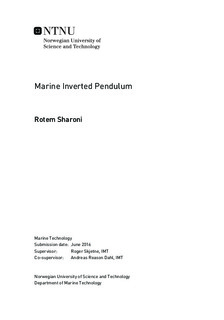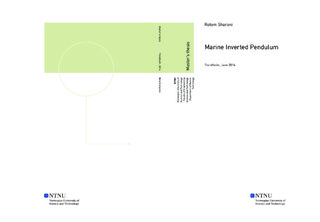| dc.description.abstract | The purpose of this thesis is to investigate whether an inverted pendulum can be balanced on a hydrodynamic platform actuated by thrusters. The vessel is the omnidirectional CS Saucer actuated by three rotating azimuth thrusters.
The vessel have been heavily modified, replacing the software control system with a Robot Operating System (ROS) based platform, using an Arduino Mega embedded circuit board, and the Raspberry Pi 2. This is a versatile platform, especially useful with MATLAB and Simulink simulations, and for implementation of additional hardware. For this project, rpm measurements from all motors have been added, along with battery voltage monitoring and encoder reading.
The encoder is used to read the position of the pendulum. A completely new payload system, interfacing the pendulum and encoder to the CS Saucer have been designed and constructed. The system is designed to only rotate in one plane, and the pendulum is restricted to move in the range $\pm 45\degree$.
In order to design a control system that keeps the pendulum at the upright equilibrium, a mathematical model of the system is needed. Equations for an inverted pendulum on a cart, and hydrodynamic modelling of marine vessels are presented, and then combined to find the equations for the system. The Lagrangian approach is used to derive the dynamic coupled equations for the marine inverted pendulum, where theory on the double inverted pendulum is used for comparison. It is also shown that the Denavit-Hartenberg convention used in robotics can be applied on the marine inverted pendulum to derive the equations.
The mathematical model is highly coupled and nonlinear. For controller and observer designs, however, it is convenient to work with a simplified model. Therefore, the system is linearized about the desired upright equilibrium and position, i.e. the zero state, and written on state space form. Based on this linear model, a linear quadratic regulator (LQR) feedback controller is designed.
Only the vessel position, pitch and pendulum angle are measured, while their derivatives also form part of the state. Since all six states are necessary for feedback control, a Luenberger state estimator is designed. Together with the LQR they form the linear quadratic Gaussian (LQG). The observer is then a combined filter and state estimator, able to reconstruct unmeasured states, and filter noisy measurements.
The system is tested in the MC Lab, where real conditions as unreliable sensors, signal losses and noise are present. Experiments show promising results for the LQR. Several runs are conducted, showing that both the control law, and vessel should be suitable for the marine inverted pendulum. The objective is not completely achieved, but it is believed that it is possible to achieve it given some more work.
One of the main concerns in this regard is the thruster mapping. The thrusters are unreliable, especially in the zero thrust region, and when thrust direction is changed. Therefore, this should be the main focus area for further work. Moreover, the vessel design might not be the best for a marine inverted pendulum. It is directionally unstable, and a strong pitching effect is observed when thruster force is applied. So, while the omnidirectional property might be very suitable for a freely moving pendulum, a long and thin vessel is believed to be more suitable for the in-plane rotating pendulum. | |

